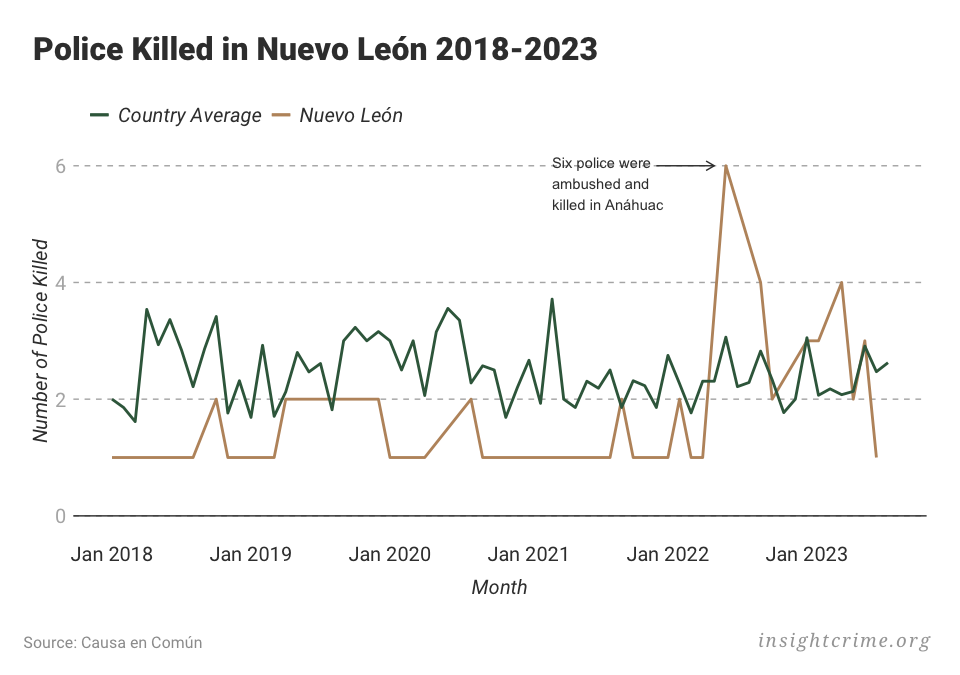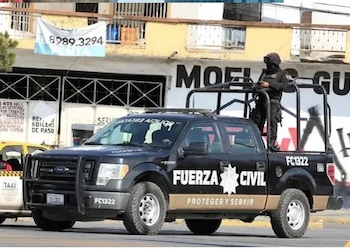Killings of police officers in Mexico’s northern state of Nuevo León have increased 143% between 2019 and 2022 amid a broader uptick in homicides, which overlaps with the Northeast Cartel’s expansion across the state.
The late-June killing of Gabriel Solano González, the municipal police chief for the city of Linares, was the latest of 16 logged in the state so far this year, according to data from Causa en Común, a watchdog group that relies on news reports from a network of journalists to document murders of police.

In 2022, Nuevo León recorded 17 police officers killed, compared to just seven in all of 2019. Due to a lack of official counting, Causa en Común says its data is more accurate than the few official statistics that are available, which are plagued by transparency and record-keeping problems.
The number of police killed in Nuevo León represents just a small fraction of the national total, but the uptick comes alongside a broader rise in violence as well. Homicides have increased almost 200 percent since 2015, from just 450 killings to 1,328 last year, according to government data.
SEE ALSO: Mexico’s Nuevo Leon Calls for Security Surge Amidst Renewed Violence
Violence here has long been tied to criminal dynamics and control of Monterrey, the prized capital city. Federal highways connect the industrial hub to the border cities of Nuevo Laredo and Reynosa, making it a crucial transit point for migrants and drug shipments heading to the United States.
At the same time, the city’s metropolitan area is one of Mexico’s most important economic centers with close ties to the United States. As such, it is an attractive place to launder large sums of illicit earnings from drug trafficking, migrant smuggling, and other criminal economies without raising much suspicion.
InSight Crime Analysis
The rise in homicides and killings of police officers in Nuevo León looks to be tied to the Northeast Cartel’s (Cartel del Noreste – CDN) push to expand beyond Tamaulipas.
Since emerging from the remnants of the Zetas, the CDN has long controlled the US-Mexico border city of Nuevo Laredo and the north of Nuevo León. But in recent years, the group has also been trying to expand further south towards Monterrey.
Since at least 2019, the CDN has battled other Gulf Cartel and Zetas splinter groups, parts of the Sinaloa Cartel, as well as the Jalisco Cartel New Generation (Cartel Jalisco Nueva Generación – CJNG) and other independent groups.
“The municipalities where they have been killing [police officers] is where the presence of new [organized crime groups] has been seen,” according to a municipal police chief outside of Monterrey who spoke to InSight Crime on condition of anonymity.
In the middle of last year, for example, a convoy of Northeast Cartel members allegedly ambushed and killed six state police officers in Anáhuac, which sits between Monterrey and Nuevo Laredo. About six months later, authorities arrested dozens of alleged Northeast Cartel members and killed six others north of Monterrey. Officials said the group had dispatched various cells from Nuevo Laredo to support efforts to take control of certain municipalities outside the capital city.
SEE ALSO: The Northeast Cartel and Criminal Hegemony in Nuevo Laredo, Mexico
Members of the group have also been implicated in several other attacks and killings of police this year in Salinas Victoria, a small municipality less than 40 kilometers from Monterrey. One municipal and two state police officers were killed after a gun battle in January, while three more municipal police officers were murdered on their day off the next month.
Across Mexico, criminal groups routinely rely on local corruption to aid expansion efforts and solidify control. Targeted violence is just one of several tactics used to force authorities to shift their allegiances away from competing groups.
“Typically, what happens when a new group enters is that they try to intimidate local authorities,” said the police chief. “They try to co-opt them through corruption and those that don’t cooperate are killed,” he added.

That said, it’s not yet clear if the group is specifically targeting police for this reason or if officers are simply being killed during confrontations to capture its members. The Causa en Común data does not track this distinction, only the location and rank of the officials killed.
Still, local corruption often plays a role in killings of police. Corrupt officers working for an opposing group can be targeted, while others may be killed simply for not cooperating and doing their job. The police chief explained that “very few municipalities confront this collusion between police and [organized crime groups].”

While the recent killings of police have troubled state authorities, the violence has not risen to levels seen more than a decade ago. During that time, the Zetas and Gulf Cartel overwhelmed authorities in and around Monterrey as the two groups fought to control the metropolitan area due to its strategic geographic and economic characteristics. In 2011 alone, nearly 100 officers were counted among the more than 2,000 homicides recorded in Nuevo León.
It is still far off, but if current trends continue, Nuevo León may see another cycle of extreme violence related to its evolving criminal landscape. Last month, the Northeast Cartel warned in a “narcomanta” left next to a dead body in Monterrey that more killings could come.
“For everyone against the Northeast Cartel, it’s better to fall in line or you’ll be killed.”

